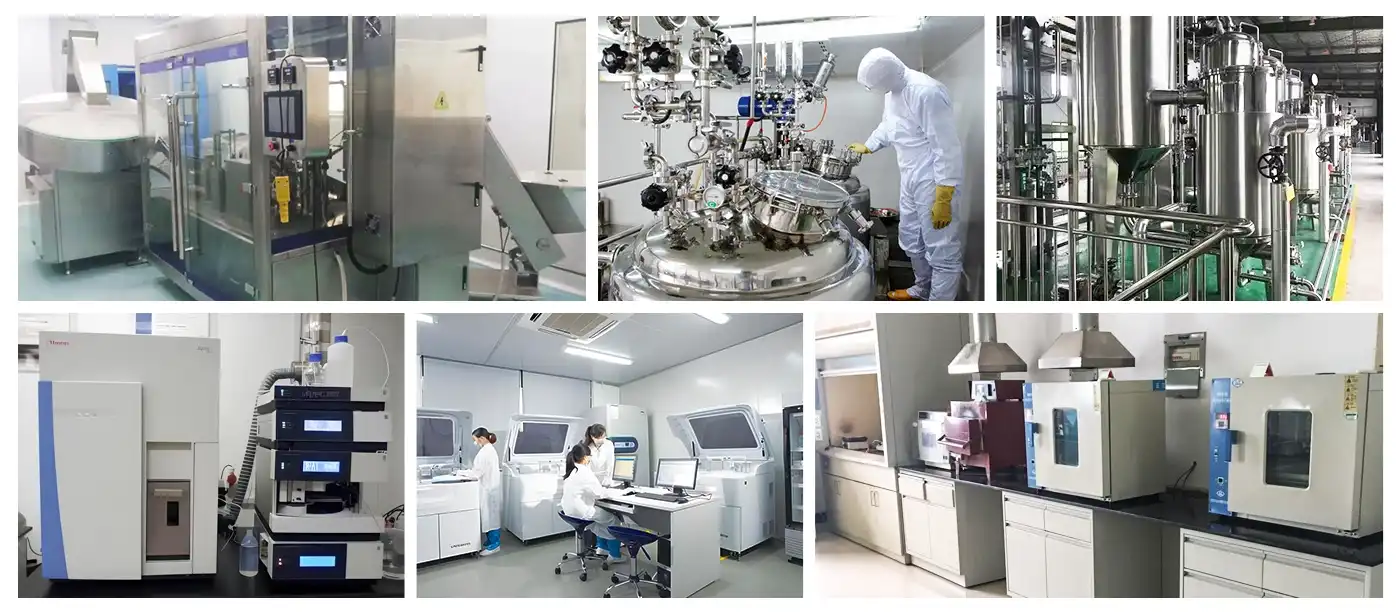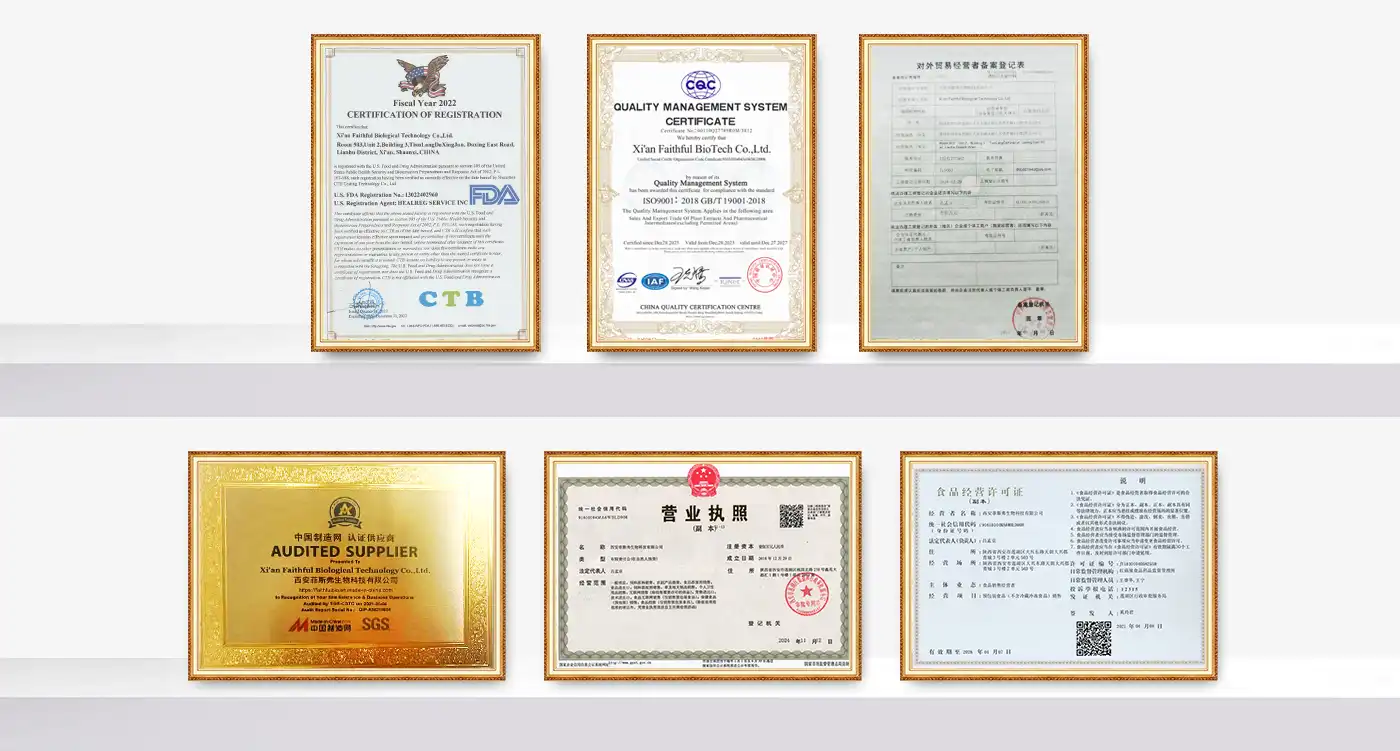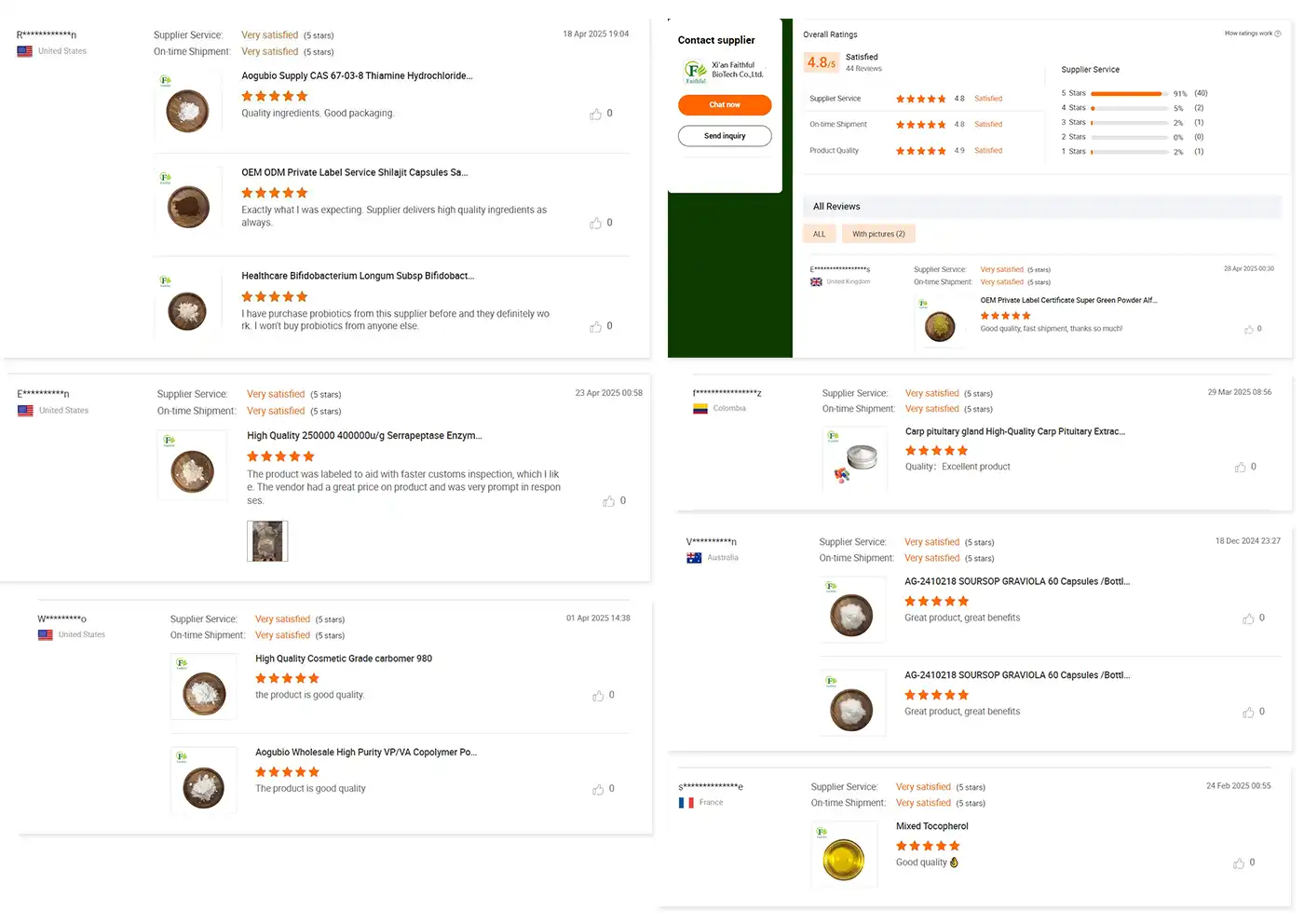Oligopeptide P11-4
Synonym: Oligopetide P11-4;C72H98N20O22;593266-60-5
CAS NO.: 593266-60-5
EINECS NO.: /
Molecular Formula: C72H98N20O22
Purity & Grade: 99%; Medicine grade
Character: White Powder
Free sample: Available
Stock: In stock
Warehouse: USA/EU/AU Warehouse
MOQ & Package: 100mg; Package according to demand
Shipping: Safe and fast delivery
Lead Time: 7-15 days
Store & Shelf life: Cool & dry place; 24 months
- Product Description
Xi'an Faithful BioTech Co., Ltd: Your Trusted Oligopeptide P11-4 Manufacturer & Supplier
Xi'an Faithful BioTech Co., Ltd. sells high-purity Oligopeptide P11-4. Our company has been deeply involved in the peptide raw material field for many years, focusing on the research and development and production of cosmetic peptides, recombinant proteins, and other products, with customers all over the world. Our Oligopeptide P11-4 product boasts a purity of over 95%, meeting the needs of various fields such as scientific research, cosmetics, and pharmaceuticals. We also offer flexible packaging specifications for Oligopeptide P11-4 and support on-demand repackaging. This flexible supply model can meet the small-batch trial needs of research institutions as well as the large-scale production needs of cosmetics and pharmaceutical companies, adapting to the procurement needs of different customers.
Oligopeptide P11-4 Introduction
Oligopeptide P11-4 is a synthetically produced, pH-controlled self-assembling peptide with core applications in oral care.
pH-controlled self-assembly: As an α-peptide, it exists as a monomer in a random helical conformation in water above pH 7.5, while in low pH environments it self-assembles into a hydrogel-like β-lamellae amyloid protein. This characteristic allows it to precisely target acidic lesions such as dental caries, avoiding premature assembly failure in a normal oral environment.
High affinity mineralization capacity: The three-dimensional biomatrix formed after self-assembly has calcium ion binding sites that match the calcium spacing in the hydroxyapatite lattice, exhibiting a strong affinity for tooth minerals. This matrix can act as a nucleation site for hydroxyapatite formation, inducing calcium phosphate in saliva to form enamel-like crystals, thus achieving tooth mineral regeneration.
COA
| Test items | Specifications | Results |
| Appearance | White powder | Conform |
| Peptide Purity (By HPLC) | ≥ 95.0% | 98. 14% |
| Related Substance | Total Impurities(%) ≤ 1.0% | 0.83% |
| Largest Single Impurity(%) ≤ 1.0% | 0.47% | |
| Assay | 95.0 ~100.0% | 98.7% |
| Conclusion | Conform with enterprise specification | |
Why Choose Us?
Solid technical capabilities and reliable quality control: As a high-tech enterprise, we possess mature technological accumulation in the field of peptide synthesis. We most likely employ the industry-leading solid-phase peptide synthesis method to produce Oligopeptide P11-4, enabling precise control of amino acid sequence assembly and avoiding problems such as excessive impurities and structural deviations during synthesis, ensuring the product meets the core quality requirements for scientific research and application.
Suitable for scientific research scenarios and tailored to specific needs: This product is frequently used in experimental research in medical and pharmacy schools, and our company understands the refined raw material requirements of scientific research scenarios. We can provide small-volume, high-purity Oligopeptide P11-4 for scientific experiments, and also provide related basic physicochemical data support, helping researchers efficiently advance research in areas such as biomimetic mineralization and enamel regeneration.
Transparent pricing system to suit diverse budgets: We establish clear tiered pricing based on purchase volume. Research institutions making small-batch purchases do not incur large costs, while cosmetics and pharmaceutical companies making large-scale purchases can enjoy bulk discounts.
Application Areas
Non-invasive treatment of early-stage caries: Early-stage caries can create acidic lesions on the teeth. Oligopeptide P11-4 can penetrate these caries-affected areas and self-assemble in an acidic environment to form a scaffold structure similar to the natural tooth matrix. This induces the deposition of calcium and phosphorus ions in saliva, forming enamel-like minerals, thus reversing and repairing caries.
Daily oral care: The biocompatibility and acid-protective properties of this peptide make it suitable for the development of consumer oral care products. On one hand, it can be formulated into anti-caries gels and professional repair toothpastes. Daily use can form a protective film on the tooth surface, resisting the erosion of tooth enamel by acidic substances in the mouth and reducing the probability of caries. On the other hand, for minor enamel damage caused by wear and tear, diet, etc., care products containing this ingredient can help repair micro-damage, and long-term use helps maintain the integrity of tooth enamel.
Biomaterials and scientific research: Its unique pH-responsive self-assembly characteristics and biomimetic mineralization ability have made it an important research object in the field of biomaterials. In laboratory settings, it is often used to study biomimetic mineralization mechanisms, serving as a model material to simulate the mineralization process of natural tissues, helping researchers explore the molecular mechanisms and material compatibility of dental tissue regeneration. Simultaneously, based on its ability to form stable hydrogels and induce mineral deposition, researchers are also exploring its potential application in the development of other hard tissue repair materials, providing technical references for the innovation of bone, dental, and other related repair materials.
Quality Control:

R&D Results:

Packaging and Transportation:


After-Sales Service:

Qualification Certification:

Transaction Feedback:

Exhibition:

FAQ
Q1: What is Oligopeptide P11-4?
A1: Oligopeptide P11-4 is a synthetic, pH controlled self-assembling peptide used for biomimetic mineralization e.g. for enamel regeneration or as an oral care agent. P11-4 (INCI name Oligopeptide 104) consists of the natural occurring amino acids Glutamine, Glutamic acid, Phenylalanine, Tryptophan and Arginine.
Q2: What is the core mechanism of action of Oligopeptide P11-4 in tooth repair?
A2: The core lies in its pH-controllable self-assembly properties and biomimetic mineralization capabilities. In the low-pH acidic environment of tooth decay formation, it self-assembles into a three-dimensional biomatrix with β-sheet-like structures, which can serve as nucleation sites for hydroxyapatite. Simultaneously, it interacts with the C-terminal telopeptide domain of type I collagen and has a high affinity for calcium ions, attracting the deposition of calcium and other mineral ions, promoting the formation of hydroxyapatite, the main component of tooth enamel, thereby achieving tooth decay repair and remineralization. Furthermore, the formed structure can also block dentinal tubules, alleviating tooth sensitivity.
Q3: What are some structurally similar related peptides to Oligopeptide P11-4?
A3: The first is QQRFEWEFE, which is its C-terminal truncated form, lacking two glutamine residues, which may weaken its self-assembly ability and binding ability to tooth minerals; the second is Ac-QQRFEWEFEQQ-NH₂, which is modified by N-terminal acetylation and C-terminal amidation. This modification can change the charge distribution and in vivo stability of the peptide, reducing the probability of degradation by carboxypeptidase.
Contact Us
Oligopeptide P11-4, a cutting-edge technology for dental restoration, is now in stock! With a high purity of ≥98%, it boasts the dual advantages of pH-responsive self-assembly and biomimetic mineralization. Directly applicable to early caries repair and enamel regeneration, it supports multiple specifications for research and mass production. Contact us now to secure your premium supply! Please contact my email sales9@faithfulbio.com.
Let's work together to turn your goals into reality.




